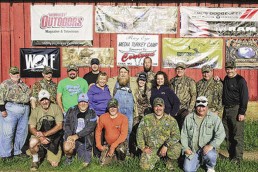Swingin’ on Double-crossin’ Turkeys
SHARE THIS POST
Gobble-obble-obble-obble, the tom sounded off in response to my soft tree yelps. I turned, facing his direction with my back resting against a large hickory tree.
Flop-flop-flop-flop, I caught a glimpse of the gobbler as he pitched down. He was out of sight just over the small ridge I’d walked down before daybreak and only 80 steps away.
I made one more series of soft yelps and the tom hammered back–the ground shook with a thunderous vibration. I shouldered my 12-gauge, pointing it in the direction of the mighty gobble, resting my left forearm on my left knee as I grasped the shotgun’s fore-end. I knocked off the safety and supported my right elbow with the other knee. He’d be 40 steps or less when he topped hill, and I was ready.
Three long minutes passed and I heard something to my right. Without moving my head, I cut my eyes toward the noise. The tom stood at 2 o’clock from my point of aim. He was dead-still and looking for the hen turkey summoning his attention.
Has this ever happened to you? I can laugh and say the same situation has happened to me more than once. A big gobbler is within range and your gun is aimed at the infinite woods from whence he came.
What do you do? What is your next move? May I suggest to you: The Swing.
You must swing (move successfully without spooking) your gun toward the big tom. Webster says it is moving and turning on a hinge or pivot with a steady rhythm or motion.
If you’re a seasoned turkey hunter, you’ve already had to swing your gun for a shot on a bird that’s slipped in. Maybe you were successful and made the shot, or maybe you blew it and missed. You can practice and prepare – make your swing on a gobbler deliberate and accurate.
There are three basic ways to swing on a turkey. You can swing fast, you can swing slow, or you can put a creep-swing on him. Whichever swing you try isn’t entirely your decision – it’s a reaction to the behavior of a tom at the moment of truth.
The slow swing
This is my favorite swing on a gobbler that’s walked in from the wrong way. He’s not in the direction your gun is pointed, but you’ve spotted him in plenty of time. He doesn’t know you’re around and his attention is on something else – hopefully a decoy or another turkey, maybe he came to your calls and is looking for you.
The slow swing is a gradual and calculated movement of the shotgun toward the turkey. It’ll usually take three seconds to go from 12 o’clock to three o’clock (90 degrees of rotation). Once the swing is started, you’ve committed; don’t stop till your sight reaches the gobbler.
If you’re hunting in the timber, let the gobbler walk behind a tree. Make the swing as soon as his head disappears and wait on him to walk into your sights.
If he’s in full strut, let him turn the backside of his fan to you, then make the swing. Wait on him to turn around, or cluck loudly to bring him out of his strut, and then blast him. I’ve successfully made slow swings on gobblers that were in wide-open green fields. A few saw my movement, but I was able to connect with the shot before they made me out.
A good way to practice a slow swing is to simulate a hunting situation. Pick a tree to sit against, similar to one you’d choose while hunting. Decide which direction will be 12 o’clock, then set out targets at three o’clock and nine o’clock – around 35 steps away. Your target can be anything: metal silhouettes, paper targets on a board or barrel, cardboard cut-outs, or maybe an aluminum drink can on a wooden stake.
Sit against your tree and make a couple practice swings to get the rhythm right before firing a shot. Prop up at 12 o’clock as if you were waiting on a gobbler to walk into your sights; make a slow swing toward one of your targets –one-Mississippi, two-Mississippi, three-Mississippi–you should be on the target with your sights.
Load your gun with one shell. Don’t use expensive turkey shells. Any shotgun shells will do. I use # 6 or #7 shot for this type of practice. Make the slow swing and fire a shot.
Practice in both directions until you are confident. Swinging to the right is more difficult for the right-handed shooter, swinging left is easier – vice-versa for the left-handed person. Be prepared to take the shot both ways, you never know where the sneaky old tom will show himself.
The creep-swing
Like all situations, the big tom will dictate your move, sometimes making a creep-swing the best choice. The gobbler slips in before you’re ready, maybe to the right, or maybe to the left. It doesn’t matter; he’s not directly in your line of sight, and is alert. He knows something is up, but hasn’t located you or the turkey he’s looking for. Any sudden movements and the tom will be gone.
The creep-swing is difficult and strenuous; if you can pull it off–it’s almost a sure kill. This is a very slow swing of the gun, a quarter-inch per second. The swing of your gun will be so slow that the turkey won’t notice any motion. It should take a minute-and-a-half (or longer) to get from 12 o’clock to three o’clock. This isn’t a timed event, so take as long as you need and don’t spook the bird. If you tire during the swing, stop for a short rest at any point, because your movement will be super-slow.
Are you enjoying this post?
You can be among the first to get the latest info on where to go, what to use and how to use it!
It’ll take patience to master the creep-swing and it’s one of the best skills to master. Use the same practice setup as before. You won’t need any shells, but you’ll need a watch with a timer.
Sit against the tree (shotgun unloaded) propped up and ready for a shot at 12 o’clock. Start the timer on your watch. Begin your swing toward the three o’clock target with a very slow movement–a quarter-inch per second. Keep your swing motion so slow that the movement isn’t noticeable.
Once the gun sight reaches the target, look at the time on your watch. If it’s less than 90 seconds, then you’ll want to try again and slow it down. If it’s more than 90 seconds, that’s what you’re looking for. Practice this toward nine o’clock the same way. There’s no need to shoot when practicing this swing. You can make the shot.
The fast swing
A fast swing isn’t your top choice, but at times it’s necessary. It’s also the highest probability that you’ll miss. That’s the way it’s worked out for me half the time–before I started practicing. You don’t want to take this kind of shot or chance if the gobbler hasn’t spotted you.
But when a turkey slips in, and by the time you see him he’s seen something he doesn’t like and is putting some real estate between the both of you. What’ll you do? Shoot or say good-bye? If you practice, you can make the shot.
If you find yourself in this situation, you’ve already taken your eyes off the shotgun and are looking at the turkey. There’s about a second, maybe two if you’re lucky, to quickly swing your gun and get the bead-sight on him. You don’t have the luxury of a slow swing. The tom has left you with two decisions: take the shot, or don’t shoot at all.
It’s almost like shooting skeet, except for the shot. Make your swing as quick as possible. When the front sight reaches the gobbler’s head, stop and squeeze off the shot simultaneously. Don’t follow through or keep the swing of the gun going past the gobbler’s head.
To practice this, set up the same as when practicing the slow swing. The only difference: put out targets at two o’clock and 10 o’clock.
Load your shotgun with one shell and sit with your back against the tree aiming in the 12 o’clock direction. Plan to swing toward 10 o’clock if you’re right-handed; if you’re left-handed, swing toward the target at two o’clock.
Start the swing quickly and count one-Mississippi. You should already be on the target. Stop and squeeze the trigger at the same time.
Practice the fast swing in both directions as much as you can stand. When you’re consistently nailing the targets, move them to three o’clock and nine o’clock. Keep practicing until you’re confident with the shot in both directions.
Things don’t always go as planned in the turkey woods. A gobbler can approach from an unexpected direction at any time. It may not be the turkey you’ve pinpointed–anything can happen. By practicing different swings, you’ll gain the skills and confidence needed to react to whatever the wily ole’ tom throws your way.
Now to finish up my turkey story:
The tom slipped in to my right, he was standing still, puffed-up in a half strut with a blood-red head. He scanned the area, looking for a hen and was less than 30 steps.
Without thinking, I immediately went into a creep-swing. I moved my shotgun toward him at the speed of a snail. The tom was getting fidgety with no hen in sight. He took a few steps and went behind a big scaly bark pine tree. Instinctively, I left the creep-swing and went into a slow swing, one-Mississippi, two-Mississippi, and my sights were on the other side of the tree waiting. The tom walked out directly into my line of fire and I squeezed off the shot. The big tom hit the ground and was done. I had a nice three-year-old bird to carry home with me.
There was a time when this scenario would have shaken me, and I might have blown it. Thanks to all the time and practice, I was ready. You can be ready, too, and your only concern will be whether to pluck and bake him or fillet the breast and have golden fried turkey nuggets.
Andy Douglas is a lifelong outdoor fanatic, and a writer with MidWest Outdoors. He fishes bass, catfish, and panfish. He hunts turkeys, deer, ducks, squirrels, rabbits, and doves, with shotguns, muzzleloaders, and archery. Douglas lives life “with a writer’s heart,” and dreams of a Canadian backpacking Dall sheep hunt.
MWO
SHARE THIS POST
Did you enjoy this post?
You can be among the first to get the latest info on where to go, what to use and how to use it!
Andy Douglas
Andy Douglas is an avid hunter, outdoor writer, and photographer. He has been chasing whitetails, big toms, bass, and most game that can be had for over 35 years. He lives the outdoor lifestyle and is passionate about sharing with others through stories and photos. Email him at AndyDouglas.Outdoors@yahoo.com



